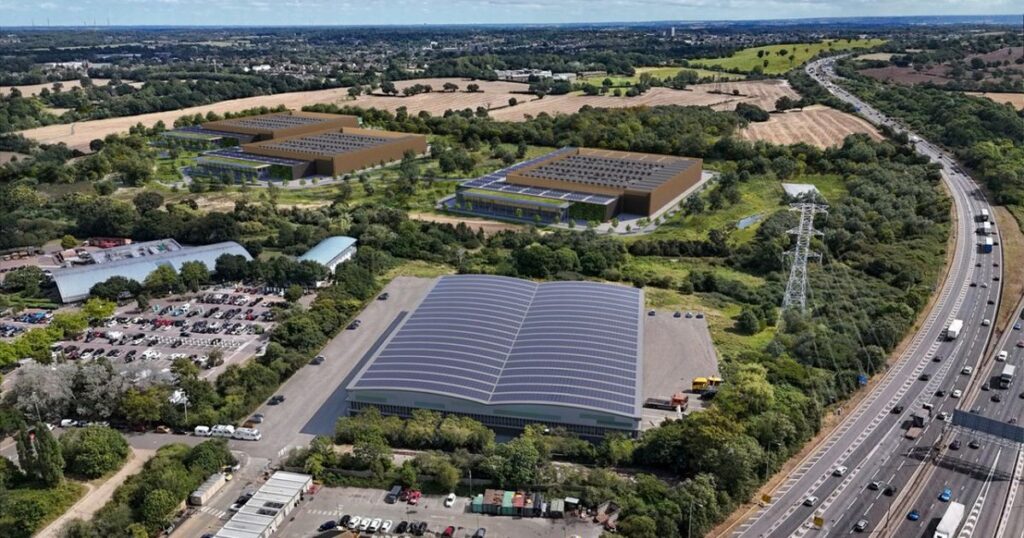A monumental £3.75bn data centre is set to reshape Hertfordshire’s tech scene.
If approved, this project will bolster the UK’s technological infrastructure with substantial economic and employment contributions.
Overview of the Proposed Data Centre
The proposed data centre in Hertfordshire represents a significant investment in the UK’s tech landscape. DC01UK’s submission outlines a massive facility, expected to cover 85 acres and deliver 2 million square feet of floor space. This infrastructure is designed to meet the growing demands for data processing and storage, driven by emerging technologies like AI and cloud computing.
Economic Impact and Job Creation
This initiative is projected to inject approximately £1.1 billion in GVA into the UK economy annually. The construction phase alone is anticipated to generate around 500 immediate jobs, with 200 more permanent roles to follow post-completion in 2029. Moreover, the ripple effects are expected to create 13,700 additional jobs across various sectors, highlighting its expansive economic influence.
The strategic placement of the data centre, close to national and international fibre optic routes, enhances its appeal. Such connectivity is crucial for maintaining the seamless operation of data-driven services.
Location and Strategic Importance
Situated near the A1 and M25, the data centre’s location east of South Mimms Services is pivotal. It offers easy logistical access and aligns with major transport routes, a factor which is instrumental in its strategic planning.
DC01UK has emphasised that the planned facility’s scale is “unrivalled” in the UK. The site is configured to draw 400MVA power from the National Grid, ensuring robust operational capabilities.
This infrastructure not only aims to cater to domestic needs but also positions the UK competitively on the global stage for technological innovation. It aligns with government strategies to elevate data centres to the status of ‘Critical National Infrastructure’.
Broader Influence on the Tech Sector
The necessity for data centres is underscored by the global rise in data-heavy technologies. Cloud computing and AI developments increasingly depend on advanced data processing facilities. Representing a substantial leap forward, the Hertfordshire site will support the UK’s ambitions for tech sector growth.
Google and Amazon have announced similar investments, reflecting a broader industry trend. Google’s £790 million project and Amazon’s £8 billion commitment to UK data centres underscore the sector’s expansion.
Despite these advancements, challenges persist, including planning hurdles. Past projects faced local governmental resistance, exemplifying the delicate balance between development and community impact.
Government and Local Perspectives
UK Technology Secretary Peter Kyle has expressed support, recognising the project’s capacity to fortify the nation’s digital infrastructure. He highlighted its essential role in housing critical data, thus boosting the economy.
Moreover, the designation of data centres as critical infrastructure marks a governmental push towards resilience in facing modern challenges like cyber threats.
Hertsmere Borough Council endorses the initiative. Councillor Jeremy Newmark cited the attractiveness of Hertsmere as a business hub, poised to become a centre of technological evolution and high-tech infrastructure development.
Current Trends and Future Prospects
The global surge in demand for data processing fuels the need for robust infrastructure. This reflects not just an increase in data centre projects but also a strategic shift in how they are integrated into national infrastructure plans.
DC01UK’s development epitomises the future of data centre evolution. It reinforces Hertfordshire’s position as a leader in technological advancements, aiming to set benchmarks for digital infrastructure.
This project is part of a larger movement to anticipate and address the data needs of the future, ensuring the UK remains at the forefront of technological progress.
Conclusion
The £3.75bn data centre project in Hertfordshire stands as a testament to the UK’s commitment to technological advancement. It promises substantial economic benefits and reinforces the UK’s position as a leader in global tech infrastructure.
This data centre could significantly enhance the UK’s digital capabilities.
Its development emphasises the critical role of data centres in modern society.


